
India’s Urban Water Crisis and the Struggle to Clean Up Sacred Rivers
✕
When taking off or landing at the Chhatrapati Shivaji Maharaj International Airport in Mumbai, India, it’s impossible to miss seeing the tight patchwork of hundreds, if not thousands, of flat roofs atop low-rise buildings in its Dharavi neighborhood of about 1 million people in less than 1 sq mile—one of the world’s largest and most densely populated slums.
Despite the official “slum” designation by India for an area where many residents don’t have basic sanitation or drinking water connections in their dwellings, the tiny community thrums with activity. Shops and small businesses are owned by the same families over multiple generations, motorcycles zip every which way through traffic and throngs of people move on a labyrinth of narrow roads.

The Dharavi wastewater treatment facility is being built on a small brownfield site within the densely populated slum of Dharavi. The sequencing batch reactor at the project’s center will enable more treatment to occur in a small space.
Photo courtesy of Welspun Enterprises, Ltd.
Tucked away inside this community, a new advanced wastewater treatment plant is being built to fill the critical need for basic services. A joint venture of Indian firms Welspun Enterprises Ltd. and EDAC Engineering has been working since July 2022 under a design-build-operate contract on the 110-million-gallon-per-day treatment complex. The $528-million project on a brownfield site includes a 55-mgd facility providing tertiary treatment, a thermal hydrolysis process to create Class-A biosolids and one of the world’s first and largest multistory sequencing batch reactors to treat wastewater. The team will operate the plant for 15 years after its estimated completion by May 2026.

The sequencing batch reactor inside a new wastewater treatment facility being built in Dharavi in Mumbai, integrates several treatment functions.
Photo courtesy Zachry
The project is one of seven being overseen by Mumbai governing body Brihanmumbai Municipal Corp., to upgrade or build new facilities to reduce environmental problems caused by significant discharges of untreated sewage and effluent into nearby bodies of water, including the Arabian Sea west of the city and several creeks to the east that flow to major rivers. The aim is to treat more effluent to higher levels for non-potable reuse, says Welspun Enterprises Ltd. Water vertical CEO Yogen Lal, and for potential potable reuse, with added treatment that has been considered but is not yet planned.
The seven plants that are part of the nearly $2-billion Mumbai Sewerage Waste Disposal program are expected to create tertiary treatment capacity for up to 50% of about 560 mgd of wastewater discharged in Mumbai each day, Lal says. “There’s a great push for circular treatment and the reuse factor,” he notes.
Under the program, the municipal entity awarded contracts in early 2022 to various firms including global water firm Suez, now part of Veolia, for projects also in Mumbai’s Worli, Bandra, Malad, Versova, Ghatkopar and Bhandup communities.
By providing more recycled non-potable but treated water to local industrial and manufacturing facilities that now use drinking-water-level supply, the city can provide more potable water to residents, Lal says. Mumbai’s population continues to grow from its current 21.6 million—and with a plan in place to redevelop Dharavi, as well as a 2022 city policy for more residential access to legal sanitation and water supply, every drop of water will count.
The Dharavi plant will take in 44 mgd of sewage from a tunnel being built by a Welspun subsidiary that originates at the airport, in addition to 66 mgd from communities near where the plant is located. The wastewater that moves through advanced treatment will convey through a new 5-mile-long tunnel being built by the Welspun unit for added treatment in Ghatkopar, or will be discharged to the nearby Mithi River via an underground duct.

Mumbai’s Dharavi community, with an estimated 1-million population, bustles with small businesses. But its official designation as a slum hampers residents’ efforts to obtain basic water supply and sanitation services.
Photo by Pam McFarland for ENR
A Pollution Problem

Original map by Getty Images/Pop Jop
The poor water quality in India’s most sacred rivers has become a political issue as awareness and anger has grown over lack of progress to reduce levels of human and industrial waste in the Ganges River and its tributaries, including the Yamuna River in Delhi. Some news reports attribute frustration over inability of the National Capital Territory of Delhi government to adequately address the problem as a primary factor in its Feb. 5 election defeat by Prime Minister Narendra Modi’s Bharatiya Janata Party. The opposition party had led the legislative assembly for nearly 30 years.
As the Delhi election campaign entered its final leg last month, Federal Home Minister candidate Amit Shah accused Arvind Kejriwal, then district chief minister, of making false promises. Kejriwal had “promised he would purify the Yamuna River in seven years and modify it just like London’s Thames River,” said Shah, also noting the defeated official’s promise to “take a dip in the Yamuna in front of Delhi-ites.”
“The [pollution] problem is clearly identified. It’s not invisible.”
Pankaj Vir Gupta, founder of the Yamuna River Project
A December report by India’s Center for Science and Environment said only 28% of the country’s urban wastewater and sewage currently receives treatment. The rest is untreated and allowed to flow into water bodies and over land. “All this treated water, and the remaining untreated amount if treated, holds an opportunity within itself: the opportunity to ease India’s urban water crisis,” the report said.
“The problem is clearly identified. It’s not invisible,” says Pankaj Vir Gupta, an architecture professor at the University of Virginia and founder and co-director of the Yamuna River Project, which published a 2018 book outlining systemic solutions that go beyond building more sewage treatment plants to allow the rivers to again be attractive and usable public spaces. “People in the municipal and governance structure see that this is a problem,” he says. “But enacting the protocols has been slower than hoped.”
While the book has generated significant interest in other countries with similar issues, it had gained little traction among India government officials, Gupta says. “Now that Modi has won the recent elections in Delhi, and declared the Yamuna cleanup to be a national priority, we may see more.”

The Dharavi wastewater treatment project, above in rendering, will include tertiary level treatment for a portion of the effluent. Because of the site’s small footprint, efforts are underway to maximize use of space.
Rendering courtesy of Welspun Enterprises
Contributing to pollution in India’s water supply sources is use of rivers as sewers by people without basic sanitation. Because of Dharavi’s official designation as a slum, “prohibitive policies” restrict residents’ ability to make wholesale changes to homes, such as adding running water and toilets, says Kareena Kochery, a partner in the Mumbai office of participatory urban architecture and design firm urbz.

The project site is shown under excavation in October 2024.
Photo by Pam McFarland for ENR
Sometimes resourceful community members find workarounds to create their own solutions, she says, but “the biggest tragedy here is that if Dharavi was not classified as a slum, [it] would have already been one of the more developed neighborhoods, at least with regards to sanitation and water supply.” Kochery adds: “If there weren’t so much red tape … people already would have made these provisions for themselves.”
But the Dharavi upgrades are getting a boost from the Adani Group, an Indian real estate development firm owned by billionaire Gautam Adani, who is working with the city’s redevelopment authority to begin construction of an ambitious $3-billion program for new commercial and residential buildings on a 27-acre former railway brownfield site there.
“There’s a great push for circular treatment and the reuse factor.”
—Yogen Lal, water business CEO, Welspun
Adani and several other company officials were indicted last November by the U.S. Justice Dept. for allegedly making misleading and false statements to potential U.S. and international investors about its ethics policies and role in securing billions of dollars’ worth of contracts for renewable energy projects in India. The firm has denied any wrongdoing.
Kochery at urbz says local residents are skeptical of the Adani redevelopment plan, which she says no one at her firm has actually seen. Her firm prefers to work more collaboratively with community members from the “bottom up” rather than “top down.” The firm has also partnered with NYU Abu Dhabi to bring its engineering students into the community to learn to adapt their knowledge to local needs, she notes.


Construction on the Dharavi wastewater treatment plant, seen here in October 2024, began in the summer of 2022 and is now well underway, with an on-time anticipated completion date sometime in 2026.
Photos by Pam McFarland for ENR
Advanced Technologies
Lal says the planned development will increase demand for drinking water supply and sanitation. With the entire treatment plant site limited to about 12 acres inside Dharavi, the project has one of the world’s smallest footprints for the amount of wastewater to be processed each day, according to Welspun leaders. As a result, the project team opted to build up, rather than out or down.
Its four-story sequencing batch reactor will use an automated Xylem continuous flow biological activated sludge system design that will integrate several treatment functions under one roof, with identical process trains built on each floor.
About half of the water treated in the 147-ft-tall reactor will undergo further tertiary treatment using advanced disc filter technology and ultraviolet disinfection. Water that has gone through advanced treatment can be used for agricultural and industrial reuse, with remaining treated wastewater discharged. The thermal hydrolysis treatment that occurs prior to anaerobic digestion is being engineered by U.S.-based technology firm Centrisys-Pondus through its local entity Bioxcent and will produce Class-A biosolids.
Challenges
The Dharavi plant sits on a brownfield site, with removal of a complex network of utility wires and cables causing some minor project delays, but Welspun’s Lal says the project is still projected to complete well before its mandated end date.
Key challenges are linked to the separate contract with the firm’s subsidiary, Welspun Michigan Engineers, for construction of the 5-mile-long, 8-ft-dia reinforced concrete-lined tunnel connecting two new deep shafts it also is designing and building at the Dharavi and Ghatkopar wastewater treatment plants. These will be constructed using a tunnel boring machine over the next seven years.
“The biggest challenge is the geology. You cannot do any soil investigation between the two shafts,” says Saurin Patel, managing director of the unit. Mumbai “is already a compact, high density city and we have tall skyscrapers along the alignment, so we cannot … determine the quality of the rock that we would be boring through. The entire geological risk is on us.”

The plant sequencing batch reactor, one of the first in the world to be built vertically in multiple stories, integrates several treatment functions into one structure.
Photo courtesy of Welspun Enterprises
The team mitigates this risk by investigating the geology incrementally just ahead of where it is blasting, using acoustic techniques to identify the type of rock that lies ahead. The rock is part of a volcanic system, so the potential exists that what is being blasted could include volcanic ash formations or uncured magma, which “can have a lot of fissures and crevices that are filled with water,” he says.
Despite challenges, the wastewater project is on pace for on-schedule completion, Lal says. The first shaft to receive incoming sewage at the Dharavi site is finished, and the sequencing batch reactor “is progressing well,” he says. The Dharavi plant is state of the art, he adds, calling the advances “transformational” and stressing major construction strides in India over the past 20 years. “There has been a lot of investment in plant equipment, formwork, you name it, and as the nation evolves, we are also trying to reduce [labor] requirements,” he says. “I think things are changing for the better.”

Cleanup of India’s Sacred Yamuna River Takes Two Approaches
Scientist and Yamuna Biological Diversity Park biologist Faiyaz A. Khudsar is passionate about saving natural wildlife and reducing water and air pollution in Delhi, India.
Speaking in a small building without air conditioning that is behind gates so nondescript you would never know the park was there unless you were looking for it, he leans forward and thumps his fists on the table emphatically to make a point.
Walking around the park later with a reporter, Khudsar eagerly searches for any evidence of new developments since the last time he walked the park earlier in the week. He looks for wildlife to demonstrate how this once barren space in an urban center now attracts native fauna, birds, snakes, wild pigs, hares—and even leopards.
In the early 2000s, this first-of-a-kind park in India was created through the efforts of C.R. Babu, now a professor emeritus at the University of Delhi Center for Environmental Management of Degraded Ecosystems, in collaboration with the Delhi Development Authority. A similar park has been built in another Delhi neighborhood and four more are planned or in development elsewhere in the city.
Although the area where the 457-acre refuge is located was once polluted and largely vacant, the park’s scientists seeded the land with specific species of plants to revitalize the soil and develop strong root systems for other native plants. According to Khudsar, seeding was needed because healthy plants had been pushed out by invasive species.
Biologists at the park also de-silted areas that had previously supported wetlands so they could return and remove pollutants contaminating the city’s waters. The goal, Khudsar notes, is to recreate natural ecosystems and biodiversity in urban settings to improve water quality in the polluted Yamuna River, the second largest Ganges River tributary. He says the returning wildlife and flourishing new plants and grasses are evidence that the project has made an impact, with air quality monitoring also showing improvements near the park location.

The Yamuna Biological Diversity Park, the first of several planned, has produced tangible results in use of wetlands and natural plants to reduce pollution in the Yamuna River, the second-largest tributary of the Ganges River. Wildlife and natural fauna are both returning to a once barren tract.
Photo by Pam McFarland for ENR
Sanitation Project Effort
The Ganges and Yamuna are two of India’s holiest rivers for many Hindus, yet they fester in a mass of domestic and industrial waste. On any given day, the Yamuna is covered by a sea of toxic white foam of surfactants, phosphates and other pollutants.
India’s federal government has made efforts over the past five years to involve state governments in addressing pollution challenges in the Ganges and its tributaries, including the Yamuna, through the Yamuna Action Plan by providing it with financial and technical assistance.

Scientist and Yamuna Park wildlife biologist Faiyaz A. Khudsar has led efforts to create and grow biological diversity parks in Delhi and elsewhere to preserve the natural heritage of urban areas and promote conservation.
Photo by Pam McFarland for ENR
The Delhi Jal Board, functioning under the Delhi state government, implements action plan projects, including those for interception and diversion of raw sewage, wastewater treatment, low-cost sanitation and riverfront development.
The board has 35 operating treatment plants across 20 different sites in Delhi, which generates about 79% more sewage than it can treat, according to the National Mission for Clean Ganga and the Central Pollution Control Board.
The action plan’s first phase was launched in Delhi from 1993-2003, with a second phase extending to India’s states of Uttar Pradesh and Haryana. In a third phase beginning in 2018, 11 projects were announced by the National Mission for Clean Ganga to conserve the Yamuna in Delhi with $195 million in assistance from the Japan International Cooperation Agency.
This effort has been integrated into the Namami Gange Program launched in 2015, with support more recently from Prime Minister Narendra Modi’s government. About 450 projects valued at nearly $4.5 billion have been greenlit, of which 270 are completed.
Delhi’s third round of projects include wastewater treatment infrastructure in three drainage zones, which had a December 2024 deadline to finish, but most are delayed.
Additionally, one project of nine smaller and decentralized treatment plants with total capacity to treat 160 million gallons per day were commissioned to reduce load on the main facilities. Seven of those are currently operating.

A study led by the Delhi Jal Board tracked pollution in the Yamuna River as new sanitation projects came online.
Chart SOURCE: DOI: https://doi.org/10.37256/fce.3120221032 This is an open-access article distributed under a CC BY license (Creative Commons Attribution 4.0 International License)
The Delhi Jal Board has faced challenges and setbacks in fulfilling its mission, which mainly revolves around water supply and sewage management, including collection, treatment and disposal of wastewater. Maintenance and upgrades have been inconsistent, with funding limitations and politics also hindering implementation of many projects.
In its monthly water quality report for last November, the Delhi Pollution Control Committee said that fecal coliform levels—with a permissible limit of 2,500 units per 100 ml as mandated by the Central Pollution Control Board—rose significantly downstream as sewage-laden drains emptying into the Yamuna River elevated the total to 7.9 million units per 100 ml.
By Pam McFarland and Neelam Mathews in Delhi

Post a Comment
You must be logged in to post a comment.






